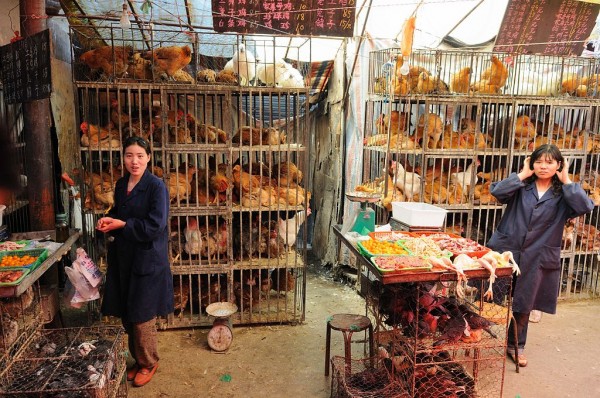Avian Flu Concerns Shutter Poultry Markets
28 January 2014 4:15 pm
0 Comments
 M M (Padmanaba01)/Wikimedia CommonsFlu source? A poultry market in China.
M M (Padmanaba01)/Wikimedia CommonsFlu source? A poultry market in China.
WASHINGTON, D.C.—With human cases of H7N9 avian influenza piling up, Chinese authorities have ordered the closure of live poultry markets in three eastern cities in a bid to stem transmission of the virus. So far, the Chinese Center for Disease Control and Prevention (Chinese CDC) says it has not detected sustained human-to-human transmission of the virus. But experts see no reason to breathe easy. If H7N9 were to acquire that ability to spread, warns Chen Hualan, director of the National Avian Influenza Reference Laboratory in Harbin, China, “it will be a disaster.”
So far in January there have been 105 confirmed human cases, according to the Chinese CDC, compared with 144 in all of 2013 after the virus emerged in China last February. Scientists concur that poultry harbor H7N9, and some suspect that quail may be the primary reservoir. But confounding surveillance, the virus does not cause discernible symptoms in poultry. While some human infections are mild, Chen notes, the mortality rate reached nearly 30% of hospitalized cases in 2013. The mortality rate has tapered and in 2014 cases is running around 20%, according to the Chinese CDC.
The timing of the uptick in cases is worrisome: Tens of millions of Chinese are about to embark on an annual migration to their hometowns to celebrate Lunar New Year, a weeklong holiday starting on 31 January. As a preemptive measure, authorities in Zhejiang province have ordered the immediate closure of all live poultry markets in the cities of Hangzhou, Ningbo, and Jinhua, according to the state news agency Xinhua. Hangzhou officials are reportedly stepping up checks at poultry farms and are attempting to halt “the flying of domestic pigeons.” Shanghai, meanwhile, plans to close its live poultry markets from 31 January to 30 April.
The situation is perilous, warns Chen, who spoke here today at the American Society for Microbiology’s Biodefense and Emerging Diseases Research Meeting. Her team and others reported last year that some H7N9 strains can be transmitted through airborne droplets from infected to naive ferrets, an animal used to model the spread of influenza in humans. “I’m pretty sure there has been human-to-human transmission in Zhejiang,” Chen told the meeting. She clarified afterward to ScienceInsider that she was referring to news reports of three infected people from the same family in Zhejiang.
Other researchers point out that the evidence for human-to-human transmission is tenuous. “There are a couple family clusters” in which investigators could not rule out limited human-to-human transmission, says George Gao, director of the Key Laboratory of Pathogenic Microbiology and Immunology of the Chinese Academy of Sciences in Beijing. But exposure to live poultry in those families could not be ruled out either, he says. “It is too early to say anything at the moment,” he says.
An H7N9 pandemic could be grim indeed. The high mortality rate is a chief concern; another is that H7N9 presents a formidable challenge for vaccinemakers. The virus is stealthier than other flu strains, “capable of evading human cellular and humoral immune response,” reported a team led by Anne de Groot of the University of Rhode Island, Providence, in the May 2013 issue of Human Vaccines & Immunotherapeutics.
“We will keep watching” for signs of sustained human-to-human transmission, Gao says, “and take a close look at every single case.”


Trackbacks/Pingbacks